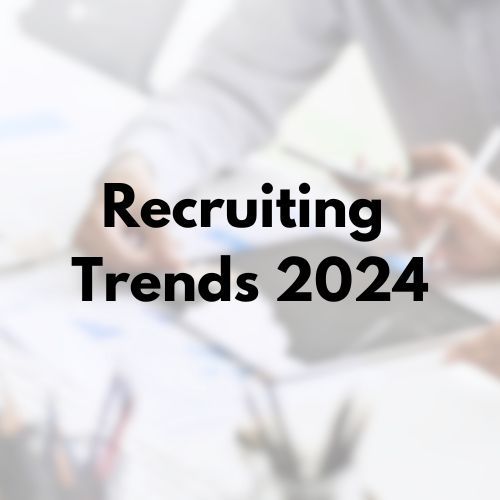News & Insights
Preparing for new recruiting trends in 2024

We’re preparing for 2024 and that means looking back at the changes in recruiting we’ve seen in 2023 and deciphering which trends are here to stay and which are being replaced by new ideas, technologies, and approaches.
We sat down with our executive team to discuss what’s emerging in the recruiting field this upcoming season.
Hybrid and in office positions are taking a front seat
All of our departments- direct placement, executive search, and recruitment process outsourcing- are seeing companies and their hiring managers either looking for candidates to fill in-person or hybrid roles over remote roles. According to the Harvard Business Review, while 50% of work was remote in the time immediately after COVID lockdowns, today the number is hovering at around 28%. As one of our clients said, “there is no replacement for being able to sit next to a team member, so we are actively trying not to hire for remote roles”.
This has implications for both hiring managers and candidates. As candidates prepare to look for new roles, they should consider that many companies are not as flexible as they once were. And as hiring managers look for in-person candidates they may need to consider that offering some level of flexibility might be necessary to get the talent level they are looking for.
Workers continue to actively and passively search for a new role
As noted in Gallup’s 2023 State of the Global Workplace, 51% of employees are either actively or passively looking for a new role. We reach out to thousands of candidates each year about potential job opportunities and we receive just as many applications for new job postings. Our research tells us that this statistic could actually be higher.
What has changed though is when in the recruiting cycle employees are quitting. We are finding that gone are the days when quiet quitting led to quitting with no new prospects in mind. Instead, we are seeing employees waiting to leave their current jobs until they have received an offer from their potential new employer. This is why we encourage companies to perform stay interviews with current employees to ensure that employees are engaged, active in their roles, and feel open to sharing feedback about what could improve their employee experience. In the same Gallup study, participants were asked, “if you could make one change at your current employer to make it a great place to work, what would it be?” Results showed that 85% of respondents answers fell into the same three categories: engagement or culture, pay, or wellbeing.
Candidates continue to value flexibility
We’ve interviewed over 2,000 candidates this year for a wide variety of roles in numerous industries and fields. “The one thing that remains true over these role and industries is that candidates are looking for flexibility- whether it be in location, schedule, or work/life balance. This is a benefit that is no longer just considered a plus but is now expected. After COVID people are looking for ways to make life and work happen simultaneously and they’re going to choose the company that allows them the flexibility to have both,” says Kristi Richtmyer, VP of Recruitment Process Outsourcing for M3..
Competition for certain roles continues
Elisha Gilroy, VP of Direct Placement and Executive Search, notes that, “We are still seeing a higher-than-average pursuit of talent in accounting, healthcare, finance, and engineering roles. These roles aren’t just about filling the position but are focused on finding the right person with the right set of qualifications that is going to actively be involved and dedicated to the growth of the company.”
And this is being seen from entry level to executive level. “In order to get in front of top candidates employers need to be willing to make more compromises that they have in the past in order to get the talent they need because talent is so scarce,” Richtmyer states.
Internal recruiting practices need to be updated
Many studies have pointed to AI as being the next big thing to happen for internal recruiters and talent acquisition managers inside of corporations. But we’re still finding that many of our partners are still looking to improve the basics before implementing new technology platforms.
A survey of all our recruiters here at M3 showed that they recommend improving processes with AI once all internal practices and processes have been brought up to speed. So, before you add in AI check to see if your practices including candidate outreach, candidate follow up times, long periods of wait times between steps, and long periods of delay in the process have all been corrected. “If you take too much time between steps or create too cumbersome of a process then the chances go up that your candidate has already found a new role,” says Richtmyer. We sat down for an in-depth interview with our team on how to update your recruiting process in this article.
Looking for help improving your processes, finding top talent, or managing the candidate negotiation process? We here at M3 would love the opportunity to show you how a true partner in talent acquisition can make all the difference for you. Email us today at hello@m3placement.com to learn more about our tailored recruitment retention services.